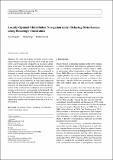| dc.contributor.author | Gregoire, Jean Matthieu Marie | |
| dc.contributor.author | Cap, Michal | |
| dc.contributor.author | Frazzoli, Emilio | |
| dc.date.accessioned | 2018-06-26T13:46:43Z | |
| dc.date.available | 2018-10-07T05:00:05Z | |
| dc.date.issued | 2017-12 | |
| dc.date.submitted | 2016-12 | |
| dc.identifier.issn | 0929-5593 | |
| dc.identifier.issn | 1573-7527 | |
| dc.identifier.uri | http://hdl.handle.net/1721.1/116601 | |
| dc.description.abstract | We study the problem of reliable motion coordination strategies for teams of mobile robots when any of the robots can be temporarily stopped by an exogenous disturbance at any time. We assume that an arbitrary multi-robot planner initially provides coordinated trajectories computed without considering such disturbances. We are interested in designing a control strategy that handles delaying disturbance such that collisions and deadlocks are provably avoided, and the travel time is minimized. The problem is analyzed in a coordination space framework, in which each dimension represents the position of a single robot along its planned trajectory. We demonstrate that to avoid deadlocks, the trajectory of the system in the coordination space must be homotopic to the trajectory corresponding to the planned solution. We propose a controller that abides this homotopy constraint while minimizing the travel time. Besides being provably deadlock-free, our experiments show that travel time is significantly smaller with our method than than with a reactive method. | en_US |
| dc.publisher | Springer US | en_US |
| dc.relation.isversionof | http://dx.doi.org/10.1007/s10514-017-9673-6 | en_US |
| dc.rights | Article is made available in accordance with the publisher's policy and may be subject to US copyright law. Please refer to the publisher's site for terms of use. | en_US |
| dc.source | Springer US | en_US |
| dc.title | Locally-optimal multi-robot navigation under delaying disturbances using homotopy constraints | en_US |
| dc.type | Article | en_US |
| dc.identifier.citation | Gregoire, Jean, Michal Čáp, and Emilio Frazzoli. “Locally-Optimal Multi-Robot Navigation Under Delaying Disturbances Using Homotopy Constraints.” Autonomous Robots 42, no. 4 (December 14, 2017): 895–907. doi:10.1007/s10514-017-9673-6. | en_US |
| dc.contributor.department | Massachusetts Institute of Technology. Department of Aeronautics and Astronautics | en_US |
| dc.contributor.department | Massachusetts Institute of Technology. Department of Physics | en_US |
| dc.contributor.department | Massachusetts Institute of Technology. Department of Urban Studies and Planning | en_US |
| dc.contributor.department | Massachusetts Institute of Technology. Laboratory for Information and Decision Systems | en_US |
| dc.contributor.mitauthor | Gregoire, Jean Matthieu Marie | |
| dc.contributor.mitauthor | Cap, Michal | |
| dc.contributor.mitauthor | Frazzoli, Emilio | |
| dc.relation.journal | Autonomous Robots | en_US |
| dc.eprint.version | Author's final manuscript | en_US |
| dc.type.uri | http://purl.org/eprint/type/JournalArticle | en_US |
| eprint.status | http://purl.org/eprint/status/PeerReviewed | en_US |
| dc.date.updated | 2018-03-13T04:50:46Z | |
| dc.language.rfc3066 | en | |
| dc.rights.holder | Springer Science+Business Media, LLC | |
| dspace.orderedauthors | Gregoire, Jean; Čáp, Michal; Frazzoli, Emilio | en_US |
| dspace.embargo.terms | N | en |
| dc.identifier.orcid | https://orcid.org/0000-0002-0505-1400 | |
| mit.license | PUBLISHER_POLICY | en_US |
